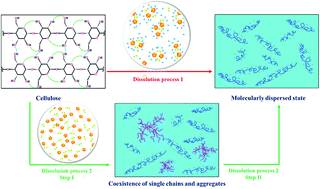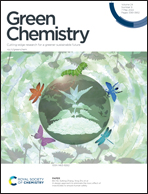The solution state and dissolution process of cellulose in ionic-liquid-based solvents with different hydrogen-bonding basicity and microstructures†
Abstract
The cellulose solution state and formation mechanism are fundamental and essential issues in cellulose science and related industry. Herein, we revealed the cellulose solution state and formation mechanism in a series of ionic liquids (ILs) and IL/co-solvent systems. The types and amounts of ILs and co-solvents have a significant influence on the initial solution state and the dissolution process of cellulose. Acetate-based ILs and a high co-solvent content are beneficial to the formation of a molecularly dispersed state. In contrast, chloride-based ILs or a low content of co-solvents make cellulose adopt a coexistence state of single molecular chains and undissolved cellulose microdomains, which gradually convert into a molecularly dispersed state. The hydrogen-bonding basicity and microstructure of ILs and co-solvents are the determining factors for the initial solution state and dissolution process of cellulose. In IL/co-solvent systems with a high hydrogen-bonding basicity (>0.92) and a small ion cluster structure, a molecularly dispersed solution of cellulose forms directly. Such a clear and comprehensive outline of the solution state, dissolution process and regulation principles is of critical significance to understand cellulose dissolution, characterize the physical properties of cellulose, control homogeneous derivatization, and process cellulose materials.



 Please wait while we load your content...
Please wait while we load your content...